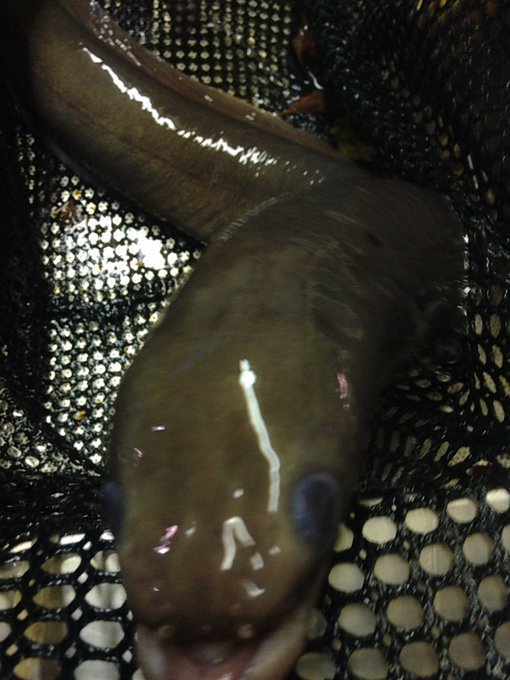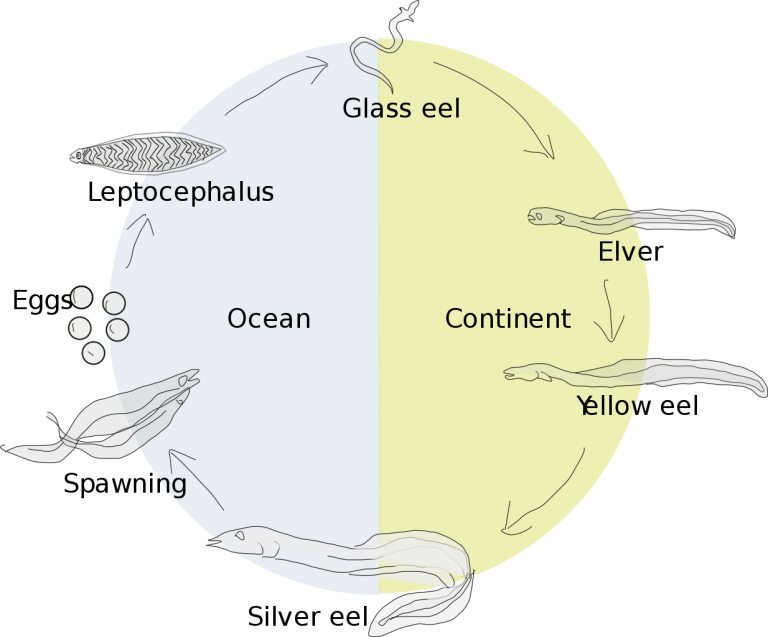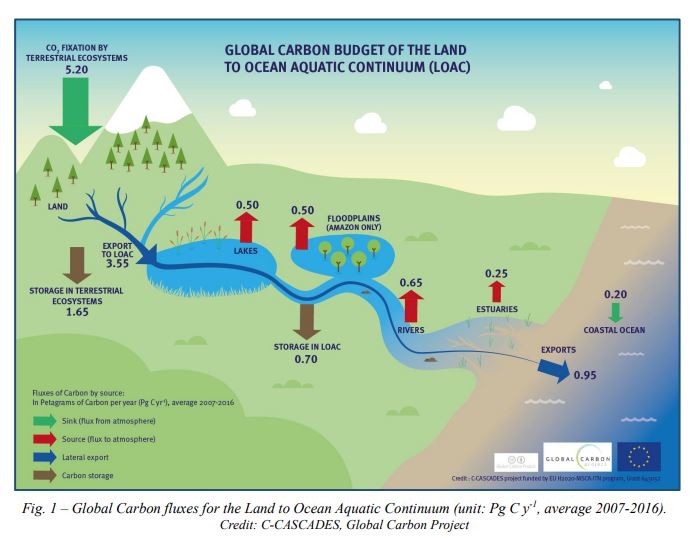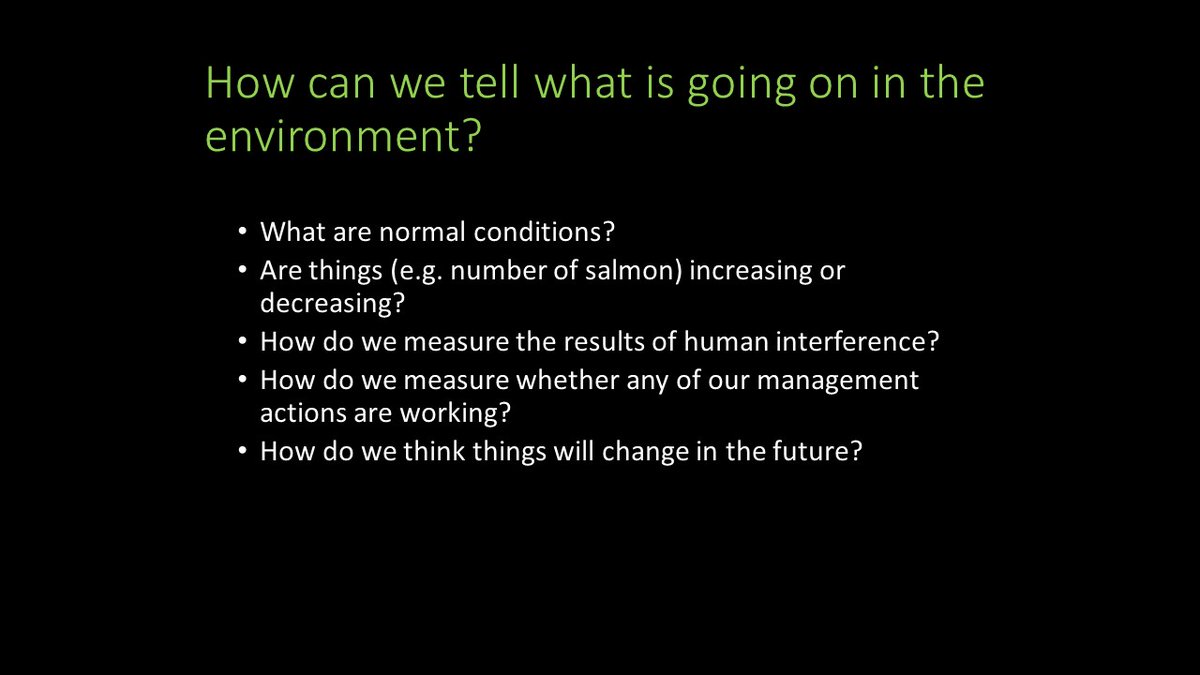
1.Friday’s 🧵is all about Eels. The species we have in 🇮🇪 is Anguilla anguilla, the #EuropeanEel, not to be confused with other Anguilla species (such as the American eel), or indeed the mighty Congor eel (Congor congor). The photo is a bit blurred because....😱 

2.European eel can be found in almost every stream and river in Europe, from the top of Norway, to the bottom of Spain, and also along the coast of North Africa 

3. Eels are catadromous which means that they spawn in the sea, and then travel back to freshwater. (Anadromous species like salmon and trout spawn in freshwater before migrating to the sea) Thanks to Filipe Romão for this informative infographic 

4. Eels go through several amazing transformations in their life, changing their body form, colour and physiology. In this infographic, the Ocean is the #Atlantic and the Continent is any of the pink areas in the map above 

5. They start out in the ocean as these fascinating flat, transparent leaf like “Leptocephali” ....... 

6.….and arrive back to the coast as #GlassEel which are a fairly popular culinary treat in some countries. Not my cup of tea🤮 

7. Glass eels (as their name suggests) are almost transparent and can hold their position in an estuary using an internal magnetic compass 🧭nature.com/articles/s4200…
8. As these glass eels change to #elvers (darker and bigger), they decide whether they are going to stick around the coast, or move into freshwater. These ones have decided they are going upstream into the #Burrishoole catchment, and were caught in our small elver trap
9. Once they get into freshwater, they grow for several decades (now called yellow or brown eel), living in the streams, rivers and lakes of the catchment. They are always a big hit when we do any kind of outreach event.... 

10. Before they decide to migrate to sea to spawn, eel undergo their final transformation into Silver eels. Their pectoral fins widen, they stop eating and their eyes grow really big. They are now ready to migrate to the Sargasso Sea. They only migrate once, and die at sea
11. Although it has been believed for over a century that eel spawning happens in the Sargasso sea, it was literally only last month that the first direct evidence was published. This was an amazing piece of work
#MysterySolved nature.com/articles/s4159…
#MysterySolved nature.com/articles/s4159…
12. Unlike salmon, which you can trace to their river of origin as all populations are genetically distinct, eel are regarded as a panmictic stock. This means that eels from Norway are similar genetically to Eels from Spain they are one big population pnas.org/doi/10.1073/pn….
13. According to #WGEEL, the working group on Eel within @ICES_ASC, eel recruitment is currently at about 5-6 % of the historical mean in the Atlantic region and there is significant mortality at all life stages doi.org/10.17895/ices.… 



@ICES_ASC 14. The global population has been in decline at least since the 1960s, with a severe reduction in the amount of juvenile eel recruitment occurring in the early 1980s 😐📉📉 

@ICES_ASC 15. Eels are listed on the IUCN red list as critically endangered and are currently the subject of specific legislation governing conservation and stock recovery measures within the European Union (EC, 2007). #BiodiversityLoss @CABioLOSS 

@ICES_ASC 16. As we learnt earlier this week, the Burrishoole traps are one of only a handful of places in the world where a full census of silver eels migrating to sea can be obtained. So what have we learnt?
https://twitter.com/IrelandsEnviro/status/1584497126205030400?s=20&t=gmUZedF_paKri9Um61XrbA
17. First of all, the eels are long-lived and slow-growing compared to many other eel populations, as the catchment is relatively unproductive (related to the underlying geology and soil type). You can age an eel by counting the rings on its #otolith (little bones in their head) 

18. With this method, @lucylou1782 and colleagues @MfrcATU @MarineInst showed that female silver eels migrating out of Burrishoole are about 30 years old, and males are about 18 years old. Yes you read that correctly 🙀academic.oup.com/icesjms/articl…
@lucylou1782 @MfrcATU @MarineInst 19. Some of the females sampled in the 1980s were more than 50 years old. Female are much bigger than males once they mature, so if you see a very big eel in the west of Ireland (more than 50 cm) its almost certainly an old female 

@lucylou1782 @MfrcATU @MarineInst 20. The European-wide decrease in the number of eels migrating is also evident in the Burrishoole catchment academic.oup.com/icesjms/articl…
@lucylou1782 @MfrcATU @MarineInst 21. Before 1982, >4000 eels per annum migrated out, while now, its more like to ∼2000 eels per annum. Almost the exact same pattern has been documented for other river in Europe with a full trap, the Imsa in Norway @EvaThorstad 

@lucylou1782 @MfrcATU @MarineInst @EvaThorstad 22. Once eels have turned silver, and are ready to make the move, they are quite specific in terms of when they will swim to sea. In Burrishoole, they migrate mostly between August and December , usually when the traps are otherwise quiet (i.e. not many salmon and trout moving) 

23. We have noticed a trend towards earlier migration of eel, with the start of the run occurring about one month earlier in 2010s, when compared to the 1970s frontiersin.org/articles/10.33…
24.But they don’t migrate every day during that period – they generally wait until night time, with a dark moon and a good bit of water. 🌘🌃🌊🌧️
25. So the eel runs are usually on the type of nights when you don’t want to be out and about and the weather is manky. Why do they do this? Probably to avoid predation onlinelibrary.wiley.com/doi/10.1002/ec…
26.Just before I finish for the day, we should not leave without mention Anguillicoloides crassus an invasive parasite of Eels, possibly one of the causes of the eel collapse. Look away now if you are having your dinner.........🍲🥘
28. A. crassus arrived in Ireland in 1997, and arrived to Burrishoole in 2011 . Michele de Noia and @martllewellyn have recently developed a non-lethal test for the worm which is 👍@B2020project doi.org/10.1017/S00311…
29.We will finish up with this great picture of Conor Nolan holding a really big eel, before it was released to continue its journey to the Sargasso Sea. Goodnight! See you tomorrow to take about the aquatic dual carriageway what is Lough Furnace. 🛣️ 

• • •
Missing some Tweet in this thread? You can try to
force a refresh

















